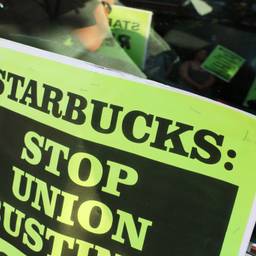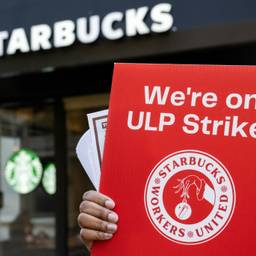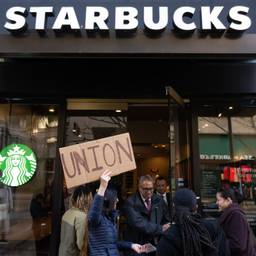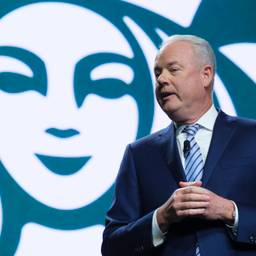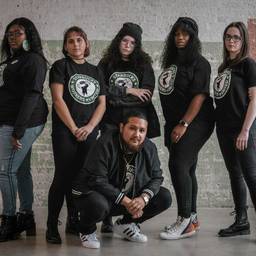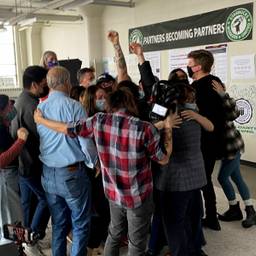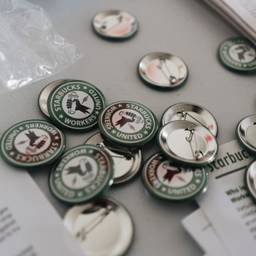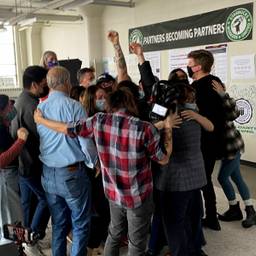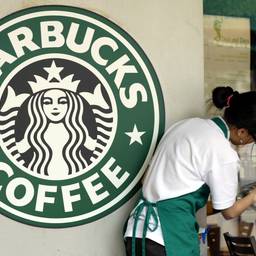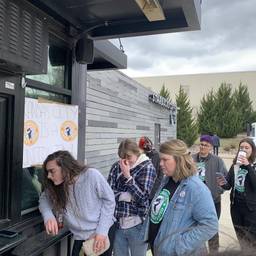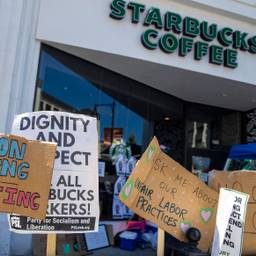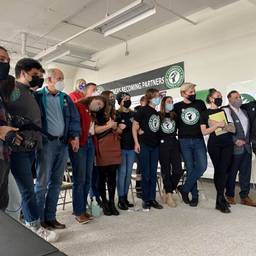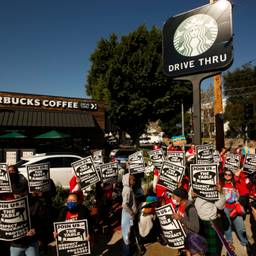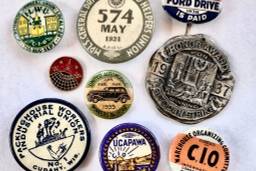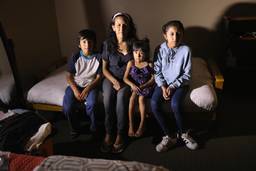How Workers Brought Starbucks to the Bargaining Table
This week, Starbucks and Workers United announced that they’d reached “a constructive path forward” on the future of organizing and collective bargaining at the company.
Natascha Elena Uhlmann
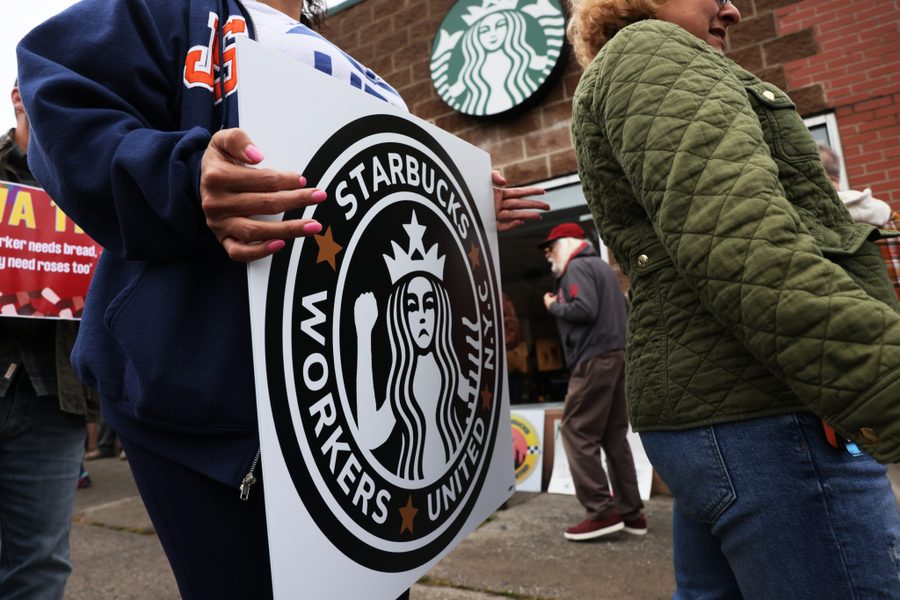
After a grueling and innovative organizing campaign characterized by stonewalling, fear mongering and retaliation, Starbucks workers are closer than ever to a first contract.
Days after Starbucks Workers United announced the largest single-day union drive in the company’s history, the union declared it had reached “a constructive path forward … on the future of organizing and collective bargaining at Starbucks.” According to the statement, Starbucks will no longer deny benefits and credit card tipping to union members, and will work towards a “foundational framework” for collective bargaining agreements. “While there is plenty of work ahead, coming together to develop this framework is a significant step forward and a clear demonstration of a shared commitment to working collaboratively and with mutual respect,” read a statement posted by Starbucks Workers United on X.
How did workers bring the corporate behemoth to the bargaining table? In this post, you’ll find a selection of some of the movement’s victories and challenges along the way.
In October, Workers United president Lynne Fox wrote about Starbucks’ efforts to conflate support for the union with support for terrorism. ”I’m the president of a union of young workers who are now terrified that they’ve been placed on a hit list by their employer,” wrote Fox. “Starbucks saw an opportunity to capitalize on the horrific and tragic events in the Middle East to further its unprecedented, illegal union busting campaign.”
Starbucks got a much-needed PR boost when it declared its intent to resume contract talks with the union in December of 2023. But with the offer came a caveat that cast their intentions into doubt: in the letter, Starbucks continued to reject the idea of hybrid negotiations (in which some unionized baristas meet in person, with others joining via Zoom). Labor reporter Steven Greenhouse wrote that, for some, “Starbucks’ message is, ’We’re saying we want to resume negotiations, but we will do so only if the union surrenders to us on this important hybrid bargaining issue.’”
In February of 2024, workers at 21 Starbucks stores across 14 states filed for union elections — in what marks the largest single-day unionization in the company’s history. Citing low pay, inconsistent scheduling, and safety concerns, workers called on Starbucks to offer them “the same respect and dignity as the CEO.” Lizzie Harlow, a Louisiana barista declared: “It’s important that we’re recognized as people rather than profit machines.”
In November 2021, a month before the first Starbucks store unionized, Derek Seidman profiled members of Starbucks’ board of directors and their history with unions. Seidman’s reporting on the nascent organizing campaign at Starbucks anticipated the company’s frenzied attempts to stifle the movement over the coming months. “At least eight of the 11 members of Starbucks’ board of directors… have represented companies with records of resisting unions or worked with groups and companies that have faced serious allegations of workers rights’ violations,” Seidman wrote.
When Hannah Faris profiled Starbucks worker-organizers in March, she found the prevailing mood to be anger. Workers told her of a set of shared grievances, from widespread staffing shortages to unlivable pay. The company’s alleged refusal to provide adequate sick leave during the pandemic spurred further organizing, as workers faced a dilemma organizer Nikki Taylor captured with the question: “[Do] I not get paid and be at home and try to be safe — and then not be paying my bills? Or go to work and continue to be exposed?”
Following a wave of Starbucks unionization across the country, workers said the company was targeting union leaders for violating minor rules that would previously go unenforced, like the policy against wearing certain pins on their aprons. “How we got fired is not why we got fired,” one worker told In These Times. While these anti-union tactics haven’t stopped the movement, organizer Richard Bensinger noted that, for every store with a successful union drive, there are several that Starbucks has crushed by firing labor leaders or simply shuttering stores.
In April, Jake Johnson covered a string of Starbucks union victories across the country amid CEO Howard Schultz’s apparent attempt to exclude unionized workers from newly instituted benefits.
Schultz announced the company was considering new benefits only for nonunion stores, saying that federal law prevented employers from changing unionized workers’ benefits without first negotiating with the union. But even after Workers United waived their right to negotiate over Schultz’s proposed changes to benefits a few weeks later, the company did not change its stance. At the time, one labor lawyer told Johnson that Schultz’s differential roll-out of benefits could “amount to evidence of an intent to bargain in bad faith by seeking to give union employees a worse deal than nonunion employees.”
The National Labor Relations Board seemed to concur: In August, Schultz was ordered to record a video apology to workers detailing his alleged violations of labor law and explaining their union rights.
In May, Maxwell Parrott covered the challenges Workers United faced in bringing Starbucks to task for what they argue are widespread violations of labor law. Starbucks worker-organizers were fighting on uneven ground: Labor law litigation, already a years-long process, was taking even longer due to understaffing at the NLRB.
Recognizing that drawn-out enforcement can have a chilling impact on organizing campaigns, NLRB general counsel Jennifer Abruzzo pushed regional offices to “aggressively seek” injunctions against employers trying to game the system. Despite the wait, some workers were holding out hope. Angel Krempa, a Starbucks employee in Buffalo, N.Y., said: “I’m fighting for reinstatement because I wanna fight for this contract…I’m not gonna just abandon them.”
“When the whirlwind comes,” wrote In These Times regular Chris Brooks in his analysis of an electrifying moment in labor organizing, “what was once seen as a risky long-shot action or fringe idea…suddenly snowballs into a series of independent, self-organized actions.” Brooks showed how organizing campaigns at stores like Starbucks and Amazon were rewriting the rules of labor struggle through worker-led militancy.
“People getting fired during a union organizing campaign isn’t having the same impact it had in the past,” said Alan Hanson, organizing director for United Food and Commercial Workers Local 400. “Most of these workers are moving from one shitty job to another anyway, so they figure that they might as well organize to make them better while they are there.”
In the aftermath of the fall of Roe v. Wade, Sarah Lazare covered Starbucks’ promise to assist workers in accessing reproductive healthcare. Within days, the company proclaimed they couldn’t “make promises” that workers at union shops would be able to access the benefit.
“To think of having to add protection of one’s ability to get an abortion to the list of things employers provide, and can therefore take away, is terrifying”, wrote Sarah. “Routine, day-to-day matters — like asking for time off, or asking a boss not to sexually harass you, or even banding together with your coworkers to organize a union — have higher stakes under this system.
In August, Zane McNeill spoke to trans Starbucks workers who reported having their gender-affirming care threatened. “You’re here for the gender-affirming surgeries and I’m worried about you [losing that benefit],” one manager told Maddie Doran, a Starbucks employee at a unionized store in Overland Park, Kan.
“Starbucks will posture that they care about queer people,” said Doran, “and they will posture that they care about any minority group, but the second you try to have a democratic workplace or speak up for yourself or don’t let them bully you — suddenly, you’re public enemy number one, and they completely shut you out.”
August marked a stunning escalation in Starbucks’ anti-union campaign. Saurav Sarkar reported on how, following a march on the boss (a popular union tactic in which workers take demands to management as a unified group), South Carolina store manager Melissa Morris filed a police report claiming she was kidnapped and assaulted by union organizers.
“We didn’t make any moves toward her, we didn’t touch her,” said Jon Hudson, a 22-year-old worker in the store.
Once a viral video emerged depicting the exchange — which lacked any aggression—cops shut down the investigation. Though the charges were dropped, the incident spoke to the lengths Starbucks goes to intimidate organizers.
In October, Starbucks employee Will Westlake told Jeff Schuhrke he was fired for wearing a suicide awareness pin.
Westlake wore the pin to honor a friend and coworker who died by suicide. Management allegedly said it was a violation of the company’s dress code, and sent him home for refusing to remove it. For Westlake, Starbucks’ opposition to the pin was rooted in anti-union animus: his deceased coworker supported unionization (the pin itself simply read, “You are not alone”). Days after firing Westlake, Starbucks invited workers to observe World Mental Health Day.
“I’ve worn non-Starbucks-related pins and gotten complimented on them by my manager,” one worker said. “And I’m talking about pins about TV shows and favorite characters. So, something as meaningful as a suicide awareness pin in a store where you’ve had a coworker pass away, that’s clearly just targeting in the most cruel and disgusting way.”
As they celebrate the one year anniversary of their union, Workers United members have made one simple request from their supporters: Don’t buy Starbucks gift cards this holiday season. They want to make it clear to Starbucks that customers want it to bargain in good faith. Workers have gained significant community support, with teachers (who frequently receive Starbucks gift cards as year-end gifts) seen as a key ally.
“[Starbucks is] trying to intimidate and bully us [and] it’s not gonna work,” said Sarah Wayment, a San Antonio-based shift supervisor. “The community has our backs.”
Just over a year after the movement’s first successful union vote, Starbucks workers raised the stakes with a three-day strike across the country in mid-December — the largest job action in the movement’s history. “We’re demanding fair staffing, an end to store closures and that Starbucks bargain with us in good faith,” said Michelle Eisen, a barista and SBWU organizer in Buffalo, N.Y.
Mere months after being ordered to apologize to workers for unlawfully denying new benefits to union stores, Starbucks is rolling out the option for customers to leave a tip with their credit card — a core union demand — at nonunion stores only.
“They’re doubling down on their union-busting, so we’re doubling down too,” said Eisen. Starbucks workers will be the first to tell you that the union campaign hasn’t been an easy one. But workers aren’t wavering.
Natascha Elena Uhlmann is a staff writer at Labor Notes.
